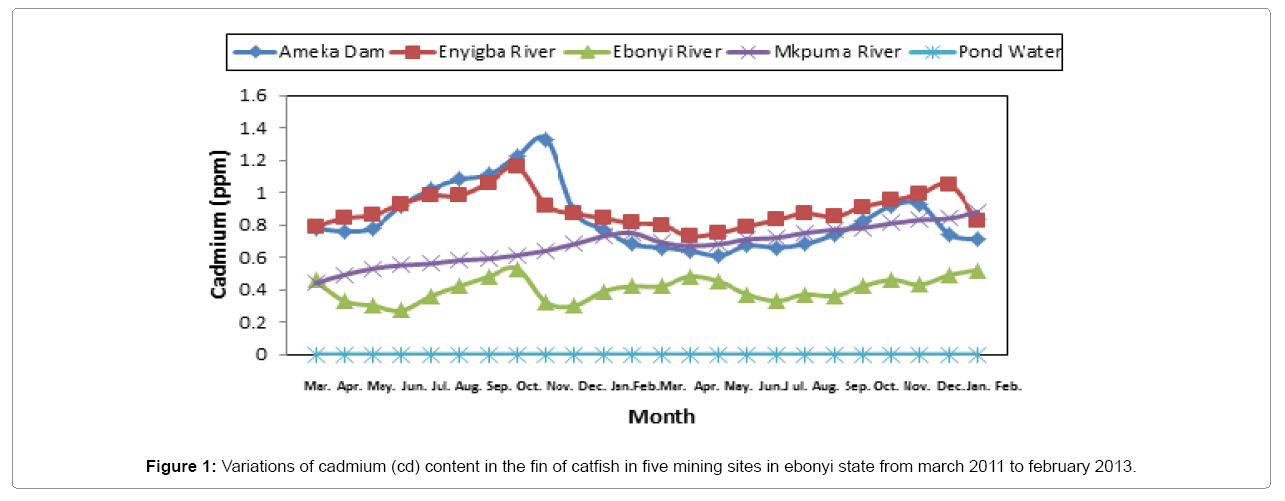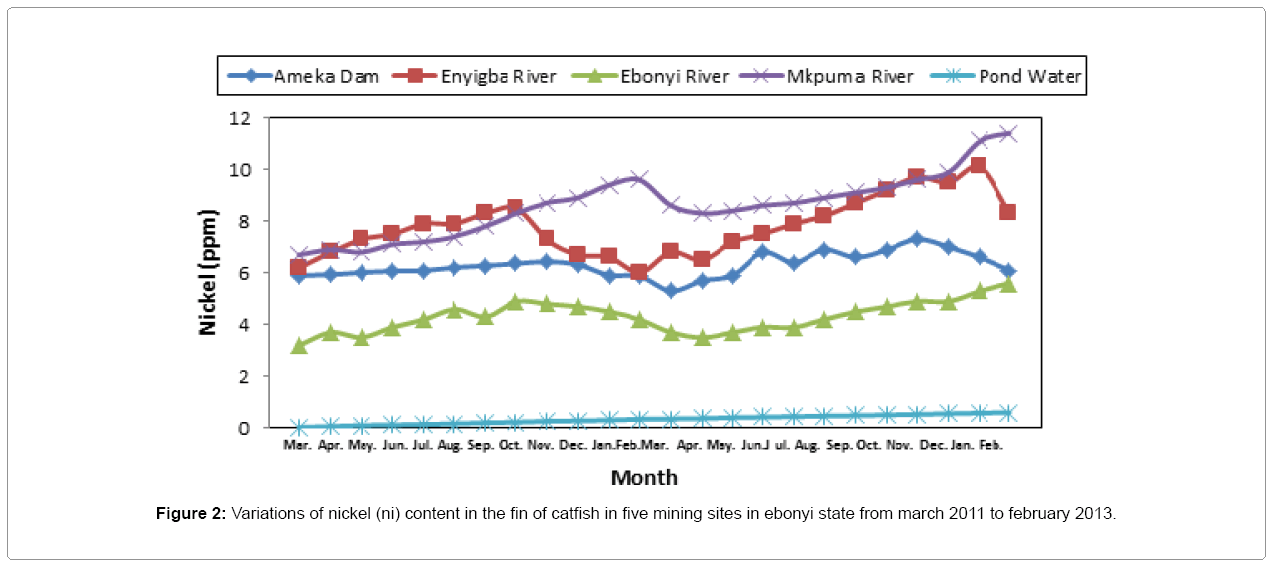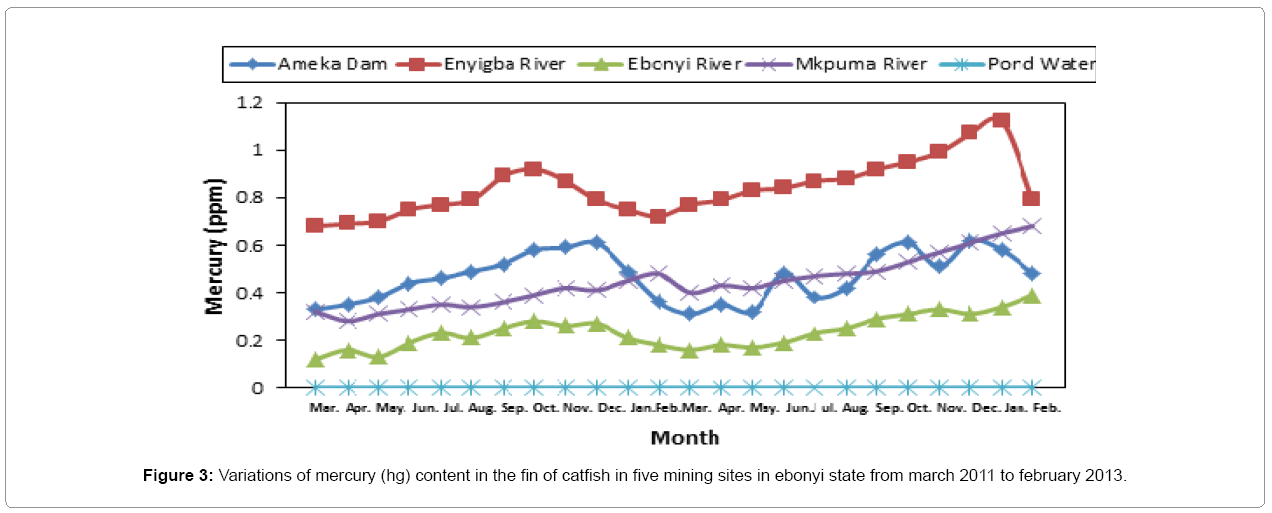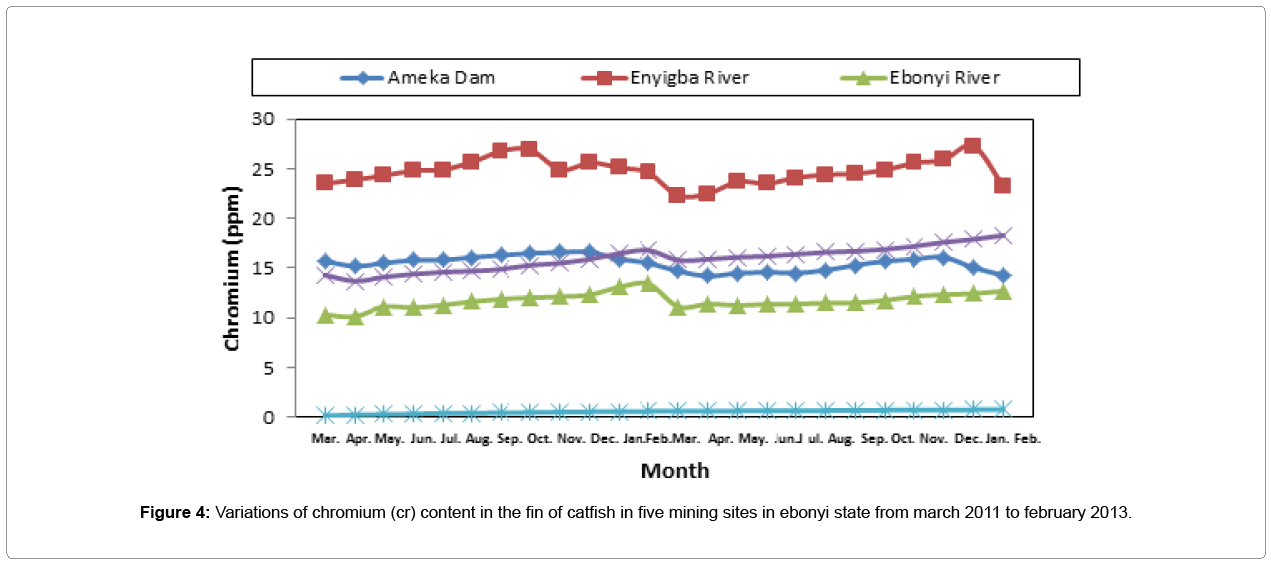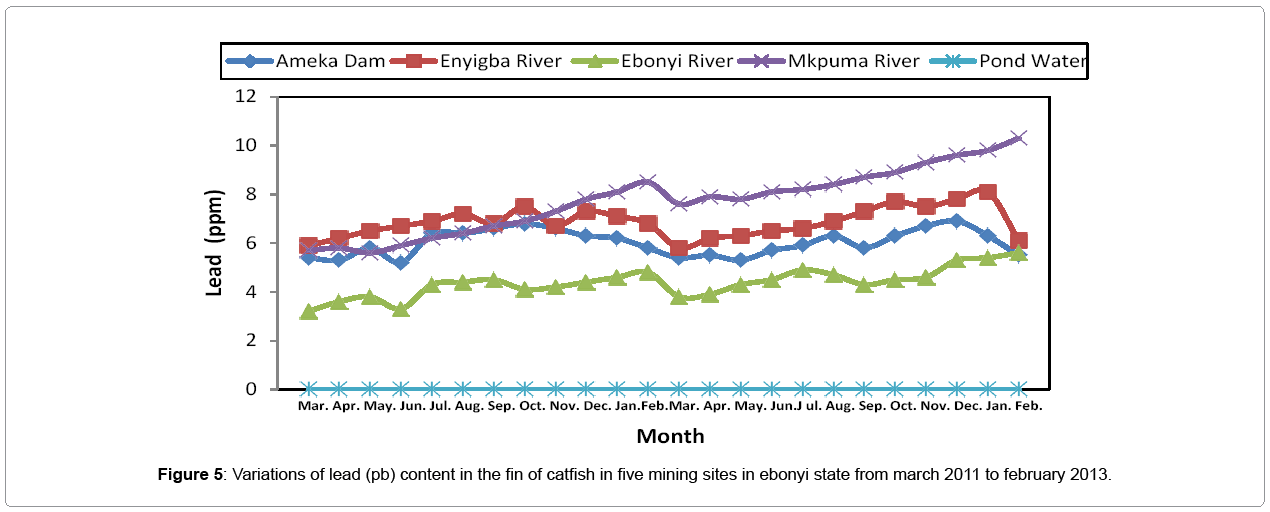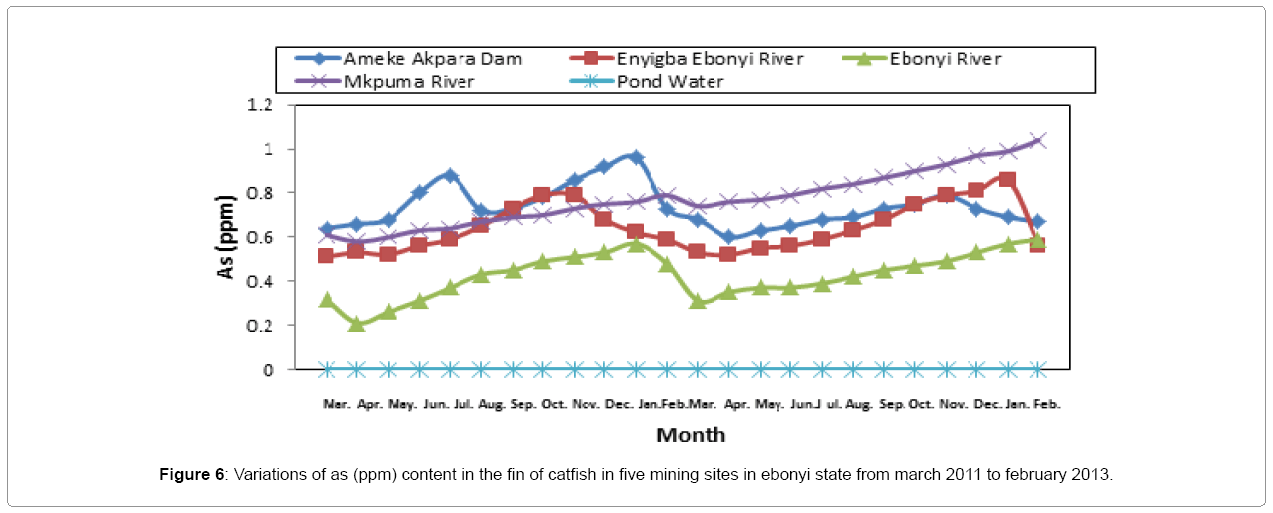Research Article Open Access
The Effects of Bioaccumulation of Heavy Metals on Fish Fin Over Two Years
Nwabunike MO*Department of Fisheries and Aquaculture, Faculty of Agriculture and Natural Resource Management, Nigeria
- *Corresponding Author:
- Nwabunike MO
Department of Fisheries and Aquaculture
Faculty of Agriculture and
Natural Resource Management
Ebonyi State University, Nigeria
Tel: +234 806 835 8468
E-mail: Evanmaur@gmail.com
Received Date: December 23, 2015 Accepted Date: February 09, 2016 Published Date: February 28, 2016
Citation: Nwabunike MO (2016) The Effects of Bioaccumulation of Heavy Metals on Fish Fin Over Two Years. J Fisheries Livest Prod 4:170. doi: 10.4172/2332-2608.1000170
Copyright: © 2016 Nwabunike MO. This is an open-access article distributed under the terms of the Creative Commons Attribution License, which permits unrestricted use, distribution, and reproduction in any medium, provided the original author and source are credited.
Visit for more related articles at Journal of Fisheries & Livestock Production
Abstract
The study analyzed the effects of bioaccumulation of heavy metals on fish fin. The objectives of the study were to analyze the overall effects of bioaccumulation of heavy metals in fish tissue (fin) over two years (Clarias albopunctatus), and to make necessary recommendations for the general improvement of fish management in the study area. Multimesh gillnets were used to monitor the abundance and structure of the fish fauna. Stratified random sampling was carried out in each water body. The fishes were caught, identified, counted, graded, measured and weighed according to species. The species for chemical and histological analysis were taken immediately after weighing to the laboratory. Concentration of metals were studied in fish in the tissue lying between the lateral lines and the fins, since high concentrations of metals do not imply that the metal have a toxic effect. It was observed that Fish fin had reduced bioaccumulation of cadmium than the blood and liver. This ranged in the running effluent areas in 2011/2012 from 0.8- 1.4 and 0.6-1.02 ppm in 2012/2013 with the two controls ranging between 0.2-0.4 ppm. Also, Nickel bioaccumulation in catfish fin had an ascending bioaccumulation during the two years with the range of 6.0-9.8 and control 1 has 3.1- 4.2. Control 2 ranged from 1.0-1.5, showing that fishes in pond water had little or no nickel bioaccumulation. It was further observed that Mercury bioaccumulation in fish fin ranged from 0.4-0.6 ppm and 0.7-1.2 ppm in Akpara Dam and Enyigba fishes respectively. Enyigba ranged 0.8 -1.2 ppm which was the highest. Ebonyi River ranged between 0.03- 0.08 which was control 1 and pond water which was control 2 had no record of bioaccumulation. Again, Chromium had bioaccumulation in fish which ranged from 15-20 ppm in Akpara and Ebonyi River and had Enyigba fish fin at the ranges of 23-29 ppm with the Ebonyi River fish fin having 9-11 ppm bioaccumulation and pond water having no record of bioaccumulation in its fish fin. Subsequently, the variation of lead and its bioaccumulation in the three running sites ranged from 0.5-1.3 ppm. The control which was Ebonyi River had a range of 0.2-0.4 ppm. The pond water had no bioaccumulation in its fish fin. Hence, bioaccumulation in fish fin increases with increasing age. The research also showed that Arsenic had a bioaccumulation range of 0.5-0.7 to 0.8-1.1 ppm in the three running sites but with the first control which was Ebonyi River fish fin registering 0.2-0.5 ppm in 2011 and 0.4-0.5 ppm in 2012 in the second control having no bioaccumulation or less than 0.1 arsenic concentration. Based on the findings of this study, the following recommendations were made: There should be periodic monitoring of the heavy metals concentration in both the fishes and river system to ensure continuous safety of people in the area. Safe disposal of domestic wastes and control of industrial effluents should be practical and where possible recycled to avoid these metals and other contaminants from going into the environment. There should be further studies on the concentration of heavy metals in other fish tissues (brain, liver, kidney, intestine, and heart) and species. Neutralization of effluent water is recommended as a modern treatment practice such as lime precipitation of effluent water.
Keywords
Multimesh; Arsenic; Heavy metals; Fauna; Quartz; Tended solids
Introduction
Fish is an important food source for the human body. Fish provide essential fatty acids like omega 3, proteins, vitamins and minerals. Despite its nutritive value consumption of fish brings many times a potential hazard concern for the human consumers [1]. Heavy metals enter the aquatic environment mainly by anthropogenic sources. Fish is at the top of the aquatic food chain, and during its life can accumulate large amounts of toxic elements. Heavy metals are defined by their weight. To be classified as a heavy metal, it must have a specific gravity of 2.7 example lead [2]. One category of toxic contaminations accumulated by fishes are heavy metals such as lead (Pb), mercury (Hg), cadmium (Cd) chromium (Cr) and arsenic (As). Any of these heavy metals can destroy life when they concentrate in the body above acceptable levels. Heavy metals have the tendency to accumulate in various organs and muscle tissue of fish. Contaminated fish enter the human body through consumption and it causes health hazards.
Currently, Ebonyi State is endowed with abundant agricultural and mineral resources as well as huge potentials for tourism development. In addition, there are many rivers and rivulets. The people of the state are traditionally farmers and are very adaptable to the natural gifts of vast land and water resources. Several mineral deposits abound at economic levels including untarnished natural salt lakes, huge deposits of granites, limestone or dolomite, variable stones, sand and gypsum. Others are bauxite, zinc, lead, quartz, copper, gold, uranium and even crude oil.
Most of these chemicals are released in nearby water bodies and lead to water pollution. Surface runoffs of soil and rock debris although non-toxic can be harmful for aquatic lives surrounding the areas. Release of toxic chemicals into the water is obviously harmful for the flora and fauna of the water bodies. Besides pollution, mining processes use water from nearby water sources [3]. Sometimes, abandoned quarry pits turn into stagnant lakes which create breeding ground for mosquitoes and black flies which spread disease within the locality. These wastes have been reported to contain toxic and hazardous substances including heavy metals, which eventually settle in bottom sediments [4,5] stated that microbial and redox processes may change the properties of sediments and affect the composition of interstitial water, while reworking of the sediments by organisms will also bring sediments to the surface, where a significant fraction of heavy metals will be released. A good knowledge of the distribution of heavy metals in water and sediments plays a key role in detecting the sources of pollution in aquatic systems [5]. Bottom sediments can therefore be used to monitor heavy metal pollution in aquatic ecosystems, Ebonyi River is vital to the people of Ebonyi State and other surrounding communities. It is important natural surface water in the area for drinking and domestic uses. There are numerous heavy metals, some of which are highly toxic, like mercury, lead, arsenic, and cadmium. Fish accumulate toxic materials at various levels, depending on species, age, season, feeding habits, and so on. None of the metals are biodegradable, and though they can change forms from solid, to liquid, to dust and gas, they never completely disappear. The ones that are toxic in even the same minute amounts create instant cellular destruction in any of their forms. Marine animals such as fish are able to readily absorb metals and their bodies regulate to accommodate their presence. They are easily stored in fatty tissue and will bioaccumulate if the fish is exposed to further contamination [6].
Heavy metals are commonly found in natural waters and some are essential to living organisms, they may become highly toxic when present in certain concentrations. These metals also gain access into ecosystem through anthropogenic and get distributed in the water body, tended solids and sediments during the course of their mobility . The rate of bioaccumulation of heavy metals in aquatic organisms depends on ability of the organisms to digest the metals in the river; it has to do with the concentration of the heavy metal in the surrounding soil sediments, and as well the feeding habits of the organism. Aquatic animals (including fish) bio-accumulate trace metals in considerable amounts and stay over a long period. Fishes have been recognized as a good accumulator of organic and inorganic pollutants [1]. Age of fish, lipid content in the tissue and mode of feeding are significant factors that affect the accumulation of heavy metals in fishes. Some heavy metals such as Zn and Fe are essential nutrients for animals and plants but are dangerous at high levels, whereas Pb have no well defined physiological functions but are detrimental at certain limits [3,7,8]. At such concentration, it may cause neurological impairment and central nervous system malfunctioning. Fish diagnoses are often used to detect and monitor these heavy metal contaminations in aquatic ecosystem. The surface drainage in the study area is irregular and consists of a number of small streams forming a dendritic pattern. The streams generally flow in different directions and empty into the Ebonyi River which is the main drainage channel serving the whole of Ebonyi State and it’s environ.
The river basin is a booming fish farming area during dry and rainy seasons. Most industrial activities in the area include: stone crushing, metal mining (Pb-Zn) and smelting. These are located less than 100 meters near the river and they discharge their wastes directly into the river. When fish bio-accumulates these pollutants, it becomes a threat to human health since consumers depend heavily in the fish for their dietary needs. In addition, the streams also which serves as both drinking and domestic water become undrinkable since it endangers human health directly or indirectly.
The Ebonyi river system is an example of the beautiful but vulnerable natural river system of the Federal Republic of Nigeria. Lack of fundamental information on the factors determining effect of quarrying activity on surrounding waters has made it imperative for such work. The chemicals used in the mining processes often escape into the environment causing large scale air and water pollution. It is pertinent to consider how mining affects its environment especially, land, water and the biodiversity. Looking at the vast deposit of mineral resources in the state, miners have been attracted to the different locations of the state for economic purpose without considering its side effects. Meanwhile, metal pollution of Ebonyi river system caused by mining has not received any serious attention and the heavy metal contamination of its fishes has not been studied. Thus, this study investigated the effects of heavy metals on the aquatic systems and fisheries of Ebonyi river system. This study tends to be of maximum benefit to the farmers, residents, NGOs, miners, environmental policy makers, Ebonyi State Government, Researchers and the general public. The residents who use the water for drinking and domestic purposes (cooking) should access if the water is not good for the health without passing through treatment processes. This knowledge will now spur them into calling for Government assistance and in the area of drinking and domestic water for public use. The outcome of the study will be useful as a guide for NGOs workers especially those working on environmental issues and human health to see how they will call for foreign donors and WHO intervention on the behalf of the residents if need be. The result of this work will sensitize miners to check or curtail direct release of the mine effluent into the environment and the water body at large. It will also help policy makers develop policies that will checkmate actions of the miners and farmers who may encroach on the dump dikes and hence causing outbreaks of effluent dump sites. Government will utilize the findings of this study by appointing monitoring agencies that will see to the full implementation of the policies made from the work and as well see how they can help process the water of both drinking and household use for public utilization.
Researchers will benefit from the study through consultation based on the work which will enable them go into further research which would be beneficial to both government and the general public. The general public will benefit through awareness creation and as well have good health or long life when the recommendations are put in place. In order to address the problem, the study tried to find out how metals accumulate and affect fish fin in Ebonyi river system. It also aimed at investigating metal impact on the biota of the natural Ebonyi River system surrounding quarry pit mines and the possible remedies to these effects.
Materials and Methods
The study area
The study area is Ebonyi State of Nigeria. The State lies approximately 7°3' N and longitudes 5°4' E and 6°45' W. It is located in the Eastern part of Nigeria. The state is made up of thirteen (13) local government areas, which are divided into three (3) agricultural zones, namely: Ebonyi North, Ebonyi Central and Ebonyi South. It has a landmass of approximately 5,932 square kilometers. It is bounded in the East by Cross River State, in the North by Benue State, in the West by Enugu State, and in the South by Abia State.
Ebonyi State has a population of 2.1 million people. The vegetation of the state is a mixture of savanna and semi-tropical forest with agriculture and mining as the mainstay of the economy. It lies in an area of moderate relief of between 125 meters and 245 meters above sea level. The soil is texturally clay loam, fairly to poorly drained, with gravely subsoil in some locations especially the upland adjacent to lowland areas. Crops grown in the area include; rice, yam, cassava, cocoyam, groundnut, cowpea and vegetables. Livestock farming, especially the extensive system of rearing sheep, goats and native cattle, is also practiced by the people. Fishing activities are predominant in all the zones of the state.
Ekpe noted that three main seasons prevail in the area - the rainy (wet) season, which spans from early April to early November, the harmattan period which lasts between mid-November to late January and the dry season, which lasts from late January to early April. However, a short dry spell is usually experienced during the month of August, and this is termed the August break. Lowland areas popularly called, FADAMA are largely available and serve as good sites for rice and fish farming during the rain and dry season vegetable farming.
Some non-farm activities prevalent in the State include: quarrying, petty trading, pottery, weaving etc. Medium to largescale industries also exist in the state. Notable among them are the Abakaliki rice milling industry, the fertilizer blending plant and the building materials industry. Large deposits of solid mineral resources such as lead, gold, gellena, zinc, iron, oxide, quartz, grease, gypsum, limestone, marble stone, common salt and others are found in Ebonyi State.
Field sampling
Three locations within the river systems in Ebonyi State, lying close to mine sites were sampled on monthly bases for two years beginning from March 2011 to February 2013. Then a river system which does not lay close to any mining site was used to serve as control 1. Then culture pond water using urban tap water to culture Clarias albopunctatus was used as control 2. Specimen of Clarias albopunctatus were collected from the ebonyi state university earthen pond and acclimatized to the laboratory conditions for fifteen days. The fishes were fed with industrial couphen industrial feed at the 3% body weight twice daily. The fishes, measuring 4 to 6 cm in length and weighing 8 to 10 gm were selected for the experimental purpose. The physiochemical parameters of the water were estimated according to Apha 1981. The test specimen were stocked in a concrete pond supplied with urban tap water. The water was changed bimonthly. The experiment was sampled monthly, for onward processing and preservation for analytical purpose. Samples for water quality were taken and analyzed in IITA according to Fishers Standard Methods (FSM standards) for sediments samples.
Multimesh gillnets were used to monitor the abundance and structure of the fish fauna. Stratified random sampling was carried out in each water body. The fishes were caught, identified, counted, graded, measured and weighed according to species. The species for chemical and histological analysis were taken immediately after weighing to the laboratory.
Concentration of metals were studied in fish blood, liver and in the tissue lying between the lateral lines and the fins, since high concentrations of metals do not imply that the metal have a toxic effect [9]. Toxicity of metals is mostly associated with vital physiological functions, such as enzyme activity, modifications in membrane, lipid composition and changes in tissue structures. The research looked at the effects of the following heavy metals (Cadmium, Nickel, Mercury, Chromium, Lead, and Arsenic) on the physiology, gill,liver, blood and fin functions of fingerlings, juveniles and table size Clarias albopunctatus in the laboratory of the Fisheries and Aquaculture Department of Ebonyi State University, Abakaliki.
Data analysis
Analysis of heavy metals bioaccumulation: After taking fork length measurements and weights of all the fishes caught from each water body, five (5) fishes were purposively selected based on age. The blood samples were collected with a syringe guage of syringe into a centrifuge vial and samples of skeletal muscles (2-3) were dissected from the left side between the dorsal fin and the lateral line of each fish. The whole livers were dissected, dressed and cleaned with HNO3. Each vial was cleaned with HNO3 for 5 hours and washed thoroughly with deionized water, rinsed 3 times, dried, (samples were dried at 105°C for about 12 hours), ground, packaged, labeled, pre-weighed and packed in plastic boxes with lids. Samples for metal bioaccumulation, enzyme and lipid analyses were taken from each fish simultaneously and placed in separate vials and delivered for analyses at 11 TA laboratory [10-14].
Determination of heavy metals Cd, Ni, Hg, Cr, Pb, and as was done using Buck 211 VGP AAS made by Buck scientific, Inc., East Norwalk. The digest of the ash of each sample above as obtained in calcium and potassium determination was washed into 100 ml volumetric flask with distilled water and made up to mark. This diluent was aspirated into the Buck 211 VGP Atomic Absorption Spectrophotometer (AAS) through the suction tube. Each of the trace mineral elements was read at their respective wavelengths with their respective hollow cathode lamps using appropriate fuel and oxidant combination.
Result Presentation
In Figure 1 Fish fin had reduced bioaccumulation of cadmium than the blood liver. This ranged in the running effluent areas in 2011/2012 from 0.8-1.4 and 0.6-1.02 ppm in 2012/2013 with the two controls ranging between 0.2-0.4 ppm.
In Figure 2 Nickel bioaccumulation in catfish fin had an ascending bioaccumulation during the two years with the range of 6.0-9.8 and control 1 has 3.1-4.2. Control 2 ranged from 1.0-1.5, showing that fishes in pond water had little or no nickel bioaccumulation.
In Figure 3 Mercury bioaccumulation in fish fin ranged from 0.4-0.6 ppm and 0.7-1.2 ppm in Akpara Dam and Enyigba fishes respectively. Enyigba ranged 0.8-1.2 ppm which was the highest. Ebonyi River ranged between 0.03-0.08 which was control 1 and pond water which was control 2 had no record of bioaccumulation
In Figure 4 Chromium had bioaccumulation in fish which ranged from 15-20 ppm in Akpara and Ebonyi River and had Enyigba fish fin at the ranges of 23-29 ppm with the Ebonyi River fish fin having 9-11 ppm bioaccumulation and pond water having no record of bioaccumulation in its fish fin.
In Figure 5 The variation of lead and its bioaccumulation in the three running sites ranged from 0.5-1.3 ppm. The control which was Ebonyi River had a range of 0.2-0.4 ppm. The pond water had no bioaccumulation in its fish fin. Hence, bioaccumulation in fish fin increases with increasing age.
In Figure 6 Arsenic had a bioaccumulation range of 0.5-0.7 and 0.8- 1.1 ppm in the three running sites but with the first control which was Ebonyi River fish fin registering 0.2-0.5 ppm in 2011 and 0.4-0.5 ppm in 2012 in the second control having no bioaccumulation or less than 0.1 arsenic concentration.
Discussion
Fish fin had reduced bioaccumulation of cadmium than the blood liver. This ranged in the running effluent areas in 2011/2012 from 0.8-1.4 and 0.6-1.02 ppm in 2012/2013 with the two controls ranging between 0.2-0.4 ppm. Variations of nickel (Ni) Content in the Fin of Catfish in Five Mining Sites in Ebonyi State from March 2011 to February 2013.
Nickel bioaccumulation in catfish fin had an ascending bioaccumulation during the two years with the range of 6.0-9.8 and control 1 has 3.1-4.2. Control 2 ranged from 1.0-1.5, showing that fish in pond water had little or no nickel bioaccumulation (Figure 1).
Variations of Mercury (Hg) Content in the Fin of Catfish in Five Mining Sites in Ebonyi State from March 2011 to February 2013 Mercury bioaccumulation in fish fin ranged from 0.4-0.6 ppm and 0.7- 1.2 ppm in Akpara Dam and Enyigba fish respectively. Enyigba ranged 0.8 -1.2 ppm which was the highest. Ebonyi River ranged between 0.03- 0.08 which was control 1 and pond water which was control 2 had no record of bioaccumulation (Figure 2).
Variations of chromium (Cr) Content in the Fin of Catfish in Five Mining Sites in Ebonyi State from March 2011 to February 2013 Chromium had bioaccumulation in fish which ranged from 15- 20 ppm in Akpara and Ebonyi River and had Enyigba fish fin at the ranges of 23-29 ppm with the Ebonyi River fish fin having 9-11 ppm bioaccumulation and pond water having no record of bioaccumulation in its fish fin (Figure 3).
Variations of Lead (Pb) Content in the Fin of Catfish in Five Mining Sites in Ebonyi State from March 2011 to February 2013 The variation of lead and its bioaccumulation in the three running sites ranged from 0.5-1.3 ppm. The control which was Ebonyi River had a range of 0.2- 0.4 ppm. The pond water had no bioaccumulation in its fish fin. Hence bioaccumulation in fish fin increases with increasing age (Figure 4).
Variations of As (ppm) content in the fin of catfish in five mining sites in Ebonyi State from March 2011 to February 2013. Arsenic had a bioaccumulation range of 0.5-0.7 and 0.8-1.1 ppm in the three running sites but with the first control which was Ebonyi River fish fin registering 0.2-0.5 ppm in 2011 and 0.4-0.5 ppm in 2012 in the second control having no bioaccumulation or less than 0.1 arsenic concentration (Figure 5).
Conclusion
In conclusion, when heavy metals accumulate in fish, they are finally transferred to other animals within the food chain. It revealed high concentrations of heavy metals such as Cd, Pb, Cu. Ni. Zn. Mn, Mg and Co in some rivers within the premises of some industrial cities in Nigeria. The discharge of industrial wastes such as mining effluent containing toxic heavy metals into water bodies may have significant effects on fish and other aquatic organisms, which may endanger public health through consumption of contaminated seafood and irrigated food crops. "Nwaedozie replied that zinc contamination affects the hepatic distraction of other trace metals in fish. Zinc, copper and manganese, are essential elements which, compete for the same site in animals [15,16].
This in no doubt, would affect tissue metal concentrations as well as certain physiological processes. Other factors such as regulatory ability, behavior and feeding habits may play a significant role in the accumulation differences in the different organs. Also the chemical nature of the metals ion; stength-and pH tends to be a master variable in le accumulation process. In acidic conditions the: are enough hydrogen ions to occupy many of the negatively charged surfaces and little space is left to bind heavy metals, hence more heavy metals remain in the soluble phase. The soluble form of heavy metals is thought to be more harmful because it is more easily transported and more readily available to aquatic organism. The result was in agreement with previous investigations on similar fish from some Nigerian rivers. Kock stated that cadmium and lead levels in Salvelinus alpimus liver and kidneys indicate higher uptake rates of both metals in summer when water temperature was higher. The data obtained by Douben indicated that the rate of uptake and elimination of cadmium by Noemacheilus barbatulus increased with water temperature. The author suggested stronger effect of temperature on metal absorption than on elimination. Water temperature may cause the differences in metal deposition in various organs. Higher temperatures promote accumulation of cadmium especially in the most burdened organs: kidneys and liver. Increased accumulation of metals by fish at higher temperatures probably results from higher metabolic rate, including higher rate of metal uptake and binding. Contamination of aquatic ecosystems with heavy metals has seriously increased worldwide attention . In the present study, it was determined that the investigated water bodies are highly contaminated by different of heavy metals, which were obviously appeared to be harmful to fish. Mean metal concentrations in water bodies near mining sites such as Ameka Dam, Akpara dam and Enyigba river were generally higher than metal concentrations in Ebonyi river and pond water. Comparing measured concentrations of metals and water quality standards, it was found that from all water bodies studied metals concentrations were higher than the permissible limits. The values of metals in fish muscles obtained in the present study were higher than those found in other localities. The present results showed that there were positive relationships between fish sizes (length and weight) and age and metal concentrations in most cases. The data showed that the negative were found only between aluminium, cadmium and mercury concentrations in muscle and sizes and age. It is generally accepted that trace element accumulation in living organisms controlled by specific uptake, detoxification and elimination mechanisms, depends significantly also on the size-specific metabolic rate of organisms. Therefore, the negative correlations between the concentration of metals and fish sizes and age do not necessarily mean that there was a particular metal concentration at the beginning of the growth period and no new metal was further absorbed, rather, it was determined by the variation of feeding rate with age of individuals, the dilution by growth and of course by the food speciation of certain age classes. Another explanation for the- negative relationships found in this study may be the difference in metabolic activity between younger and older fish. Some metals do not increase in concentrations with age or size because they were thought to be under homoecstatic control. So in the present study, the positive correlation between some metals and fish age and sizes may be due to loss of homeostasis capacity of the fishes under chronic metal exposure leading to bioaccumulation. This assumption is supported well also by the fact that lipid as a percent of body weight is usually lower in younger fish, decreases during winter and spawning and reaches its peak at the end of the main feeding period.
Based on the findings of this study, the following recommendations were made:
• There should be periodic monitoring of the heavy metals concentration in both the fishes and river system to ensure continuous safety of people in the area.
• Safe disposal of domestic wastes and control of industrial effluents should be practical and where possible recycled to avoid these metals and other contaminants from going into the environment.
• There should be further studies on the concentration of heavy metals in other fish tissues (brain, liver, kidney, intestine, and heart) and species.
• Neutralization of effluent water is recommended as a modern treatment practice such as lime precipitation of effluent water.
References
- Gado MS, Midany SA (2003) Studies on some heavy metals pollutants in cultured Oreochromisniloticus fish at kafer EI-Sheikh Govvernorate. Kafer EI-Sheikh. Veterinary Medicine Journal 1: 83-95.
- Mahdy AA, Trok TY, Arel MA (1993) Heavy metal pollution in drinking water and methods of removals. Alex Journal of Veterinary Science 9: 65-69.
- Nadal MM, Schuhmacher M, Domingo JL (2004) Metal pollution of soils and vegetation in an area with petrochemical industry. Science Total Environment 321: 59-69.
- Ademoroti CMA (1996) Standard methods for water and effluent analysis. Foludex press Ltd. Ibadan182.4
- Forstner U, WittmannGTW (1981) Metal Pollution in the aquatic fishes, formed at different pH: aging effects on metal solubility and extractability by citrate. EnvironToxicology and Chemistry20: 122-126.
- Sindayigaya E, Cauwnbergh RV, Robberecht H, Deelstra H (1994) Copper, Zink, iron, lead, cadmium, mercury and arsenic in fish from lake Tanganyika Burundi. The science of Total Environment 144: 103-115.
- Ochieng EZ, Lalah JO , Wandiga SO (2007) Analysis of heavy metals in water and surface sediment in five Rift Valley Lakes in Kenya for transpose assessment of recent increase in anthropogenic activities. Bulletin of Environmental Contamination Toxicolology 79: 570-576.
- Kar D, Sur P, Mandal SK, Saha T, Kole RK (2008) Assessment of heavy metal pollution in surface water. International Journal of Environmental Science and Technology 5: 119-124.
- Petterson AJ, Andersen RA, Zachariassen KE (2002) Effect of dietary intake of trace metals on tissue contents of sodium and calcium in mice (Mu musichis). Comparative Biochemistry and Physiology Part C.Toxicology and Pharmacology132:83-90.
- Goyer RA (1992)Toxic Effects of Metals. In: AmdurMO, DoullJ, KlassenCD (eds.) Casarett and Doull, Toxicology, the Basic Science of Poisons. Pergamon Presspp: 623-680.
- MasonCF (2002)Water Pollution Biology. In: Pollution Causes, Effects and Control. In: HarrisonRM (ed.)82:112.
- OguzieFA (2002) Heavy metals in the sediments of the Lower Ikpoba River, Benin City, Nigeria.Sri Lanka Journalof Aquatic Sciences7: 35-44.
- Pagenkopf GK (1983) Gill surface interaction model for trace-metal toxicity to fishes: role of complexation, pH, and water hardness. Environment Science and Technology17: 342-347.
- TurkmenM (2008) Phase II Investigation of Sediment Contamination in White Lake. EPA-905-R-04-001.
- Rajamanickam VS, NarayananM (2009)The impact of toxic heavy metals on the hematological parameters in common CARP (Cyprinuscarpio l). Iran J Environ Health SciEng6: 23-28.
- Zienab I, SolimanMF, GalabM (2001) A study on lead pollution in water and tilapia fish in Manzala lake. J EgyptVerMed Assoc61.
Relevant Topics
- Acoustic Survey
- Animal Husbandry
- Aquaculture Developement
- Bioacoustics
- Biological Diversity
- Dropline
- Fisheries
- Fisheries Management
- Fishing Vessel
- Gillnet
- Jigging
- Livestock Nutrition
- Livestock Production
- Marine
- Marine Fish
- Maritime Policy
- Pelagic Fish
- Poultry
- Sustainable fishery
- Sustainable Fishing
- Trawling
Recommended Journals
Article Tools
Article Usage
- Total views: 18870
- [From(publication date):
June-2016 - Aug 30, 2025] - Breakdown by view type
- HTML page views : 17069
- PDF downloads : 1801

